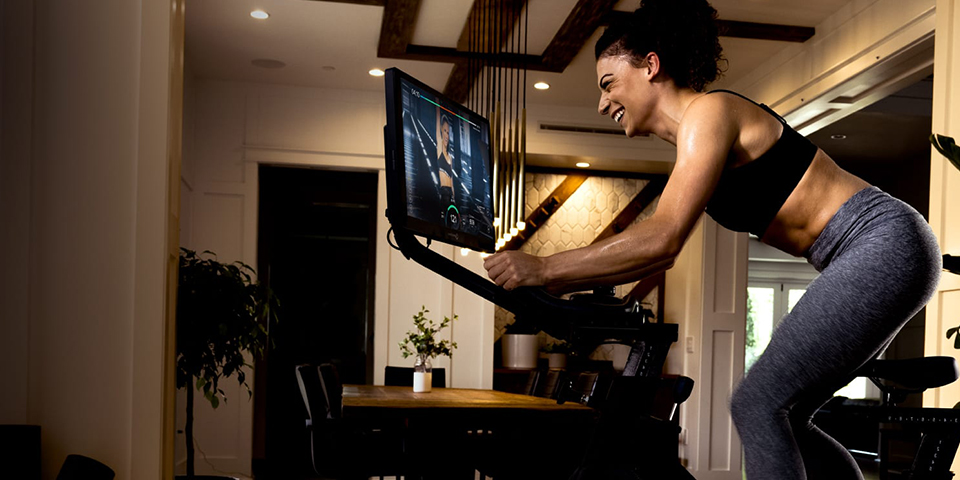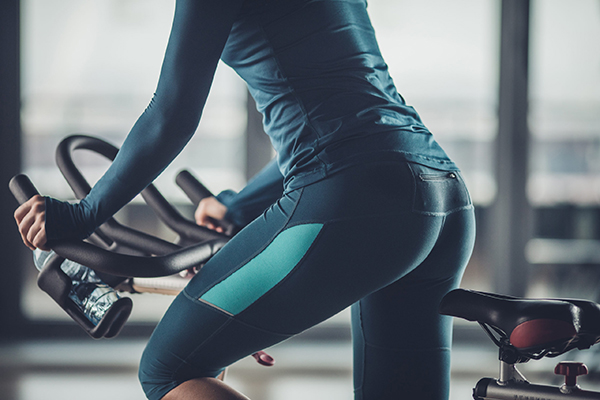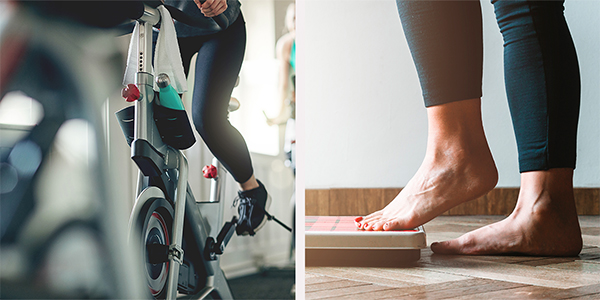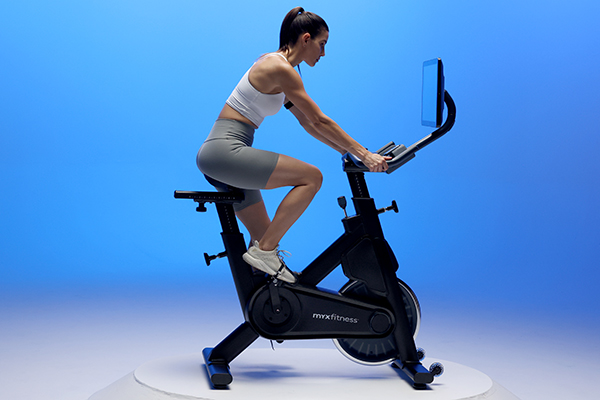Indoor cycling’s benefits are numerous; as a workout, it’s convenient, efficient, effective, and as social as you want it to be. You can do it in a class of one or dozens, depending on your mood. And these stationary bike benefits scarcely scratch the surface.
“I’m biased toward indoor cycling as a truly fun exercise that is also a great way to lose weight,” says Jake Maulin, CPT, a certified personal trainer and cycling instructor in Naples, Florida. “Stationary bikes offer a high-powered, blood-pumping cardio workout that can accelerate weight loss without stressing your joints the way running or other higher-impact workouts can.”
Here’s what science and the experts say about the benefits of a stationary bike workout.
10 Stationary Bike Benefits
Looking for your reason to start indoor cycling? The following stationary bike benefits range from weight loss to improved mood.
1. May help with weight loss
“Indoor cycling is great for weight maintenance and losing weight,” says Melanie Melillo, CPT. “Adding resistance to the flywheel can help build muscle mass. When you have more muscle, you have a more active metabolism, and you’re going to burn more calories at rest.”
In one study involving sedentary overweight women who undertook a 12-week indoor cycling course (with three sessions a week), participants lost weight and body fat while increasing their lean body mass — “without any restriction on food consumption.” Additionally, the women saw a reduction in their resting heart rate, a sign of increased cardiovascular fitness.
And a 2019 study published in the Journal of Sports Medicine and Physical Fitness found that indoor cycling resulted in greater weight loss and body fat loss compared to other fitness classes like Zumba and Body Pump, a combination of classes, and a sedentary control group.
2. May improve cardiovascular fitness
“Primarily, cycling is a cardiovascular exercise, so that means you’re going to burn calories, strengthen your heart, and strengthen your lungs when you do it,” says Melillo.
A 2019 review of studies on the health benefits of indoor cycling found that it may improve blood pressure, lipid profile (the level of fats in the blood, like cholesterol and triglycerides), and body composition — all things that may help contribute to a healthier heart.
And according to a 2020 randomized controlled trial published in the Journal of Sports Science and Medicine, indoor cycling may reduce arterial stiffness — a potential contributor to hypertension and cardiovascular disease — after just one session, making it a good activity to combat the effects of the sedentary winter months.
3. May increase VO2 max
The 2019 review of studies on indoor cycling found that it might improve aerobic capacity, or the body’s ability to use as much oxygen as it can, as efficiently as possible. It’s one marker of cardiorespiratory fitness.
“VO2 max may not mean much to the casual cyclist, but it’s a strong prerequisite for cycling performance and is a metric that many competitive athletes obsess over,” says Maulin. “While genetics impose a ceiling on how high a rider’s aerobic capacity can get, training can positively impact your VO2.”
4. May increase muscle strength and tone
“Cycling is great for the lower body, because you can resistance-load,” says Melillo. “It’s sort of like adding plates to a leg press: As you add resistance to the flywheel on your bike, you’re making it harder for your legs to pedal, so you can build muscle and make yourself stronger.”
There are aesthetic advantages, too. “The resistance element of cycling can build more defined glutes, hamstrings, quads, and calves, giving riders a toned and healthy appearance,” says Maulin.
5. Low-impact
Indoor cycling is easier on the muscles and joints than some other types of cardio. “Cycling is lower-impact than other forms of aerobic exercise, like running or high-intensity classes, because you’re not actually leaving the ground,” says Melillo. “You’re staying connected to your pedals throughout the entire pedal stroke.”
6. May help improve mood
The runner’s high is no myth — you know that a good cardio workout can make you feel great. And at least one study suggests that indoor cycling may help improve your mood. A 2015 study published in the Journal of Mental Health found that indoor cycling sessions increased participants’ positive affect (e.g., optimism, energy, and joy) and decreased negative affect, whether the sessions were self-directed or led by an instructor.
“The physical exertion is a catharsis for releasing pent-up emotions and can clear your head so you can act more decisively and be the best version of yourself,” says Maulin.
We can’t promise you’ll have a psychological breakthrough on the bike, but the science is pretty clear that exercise can really improve your mental health.
7. Can help relieve stress
Not only may those feel-good endorphins help to improve your mood, but they may also help to decrease stress.
“Exercising in general helps reduce stress,” says John Gardner, a NASM-certified personal trainer.
And heading outdoors for a bike ride can have extra benefits for your mental wellbeing. “Taking in fresh air and feasting your eyes to the glories of nature, it can be an excellent way to reduce stress and exchange any negative energy you have with feel-good brain chemicals,” Gardner adds.
8. Suitable for all fitness levels
There’s as much to be gained on a stationary bike for Tour de France champs as there is for beginners. Numerous variables — including flywheel tension, pace, and ride duration — can be adjusted to make stationary bike workouts more accessible to noobs or more challenging to advanced riders.
9. May aid cognition
A 2020 study found a connection between daily exercise and creativity. “If you’re stuck on a problem at work, or are feeling low due to shortened winter days, maybe all you need is to take a bike ride during your lunch break,” Craig suggests.
Research suggests regular exercise may also have a positive effect on other cognitive functions such as memory and attention.
10. It’s safe
Your chances of getting hit by a car in your living room are almost zero, something that can’t be said when riding a road bike. Fatalities and serious injuries among cyclists hit by cars and trucks are on the rise, so if you prefer that your workouts be of the pedaled variety, a stationary bike is your safest bet.
Types of Stationary Bikes
The results you get from indoor cycling may rest in part on your choice of exercise bike.
Indoor cycling (or studio) bike
Closest in form and function to a conventional outdoor bicycle, a studio bike like the BODi Bike by MYX situates the pedals directly beneath the rider, and the handlebars farther from the seat than other types of stationary bike. This encourages a more forward riding position, as well as the ability to stand in the saddle for the more intense workouts common to Spin classes.
Upright exercise bike
Similar in principle to an indoor cycling bike, but with several crucial differences, an upright bike shortens the distance between the seat and handles, which are typically placed higher than the seat. This places more of the rider’s weight on the seat as opposed to the wrists and discourages standing in the saddle, limiting overall muscle recruitment and workout intensity.
Recumbent bike
Placing the rider low to the ground in a reclined position, a recumbent bike situates the pedals in front of the rider for a lower-impact workout. A recumbent bike also provides back support, taking strain off the lower back and wrists, and generally involving less overall muscle engagement and intensity.
Dual-action bike
Adding more of an upper-body element to the riding experience, dual-action bikes incorporate moving handles that share resistance with the flywheel, which is often represented by a fan. The nature of that resistance makes each revolution harder the faster you try to pedal. Dual-action bikes are manufactured in upright and recumbent versions.
Bike trainer
Used in combination with a traditional bicycle, a bike trainer allows you to turn a normal bike into a fitness bike. Technologies across bike trainers vary, incorporating simple resistance stands, free-spinning rollers, or built-in gear sets that replace the bicycle’s rear wheel. These options can all vary the resistance, stability, and overall ride experience.
What Muscles Do You Use for Cycling?
According to Melillo, cycling mainly trains the following muscles:
“It’s primarily those big leg muscles that are working,” she says. “However, you’re definitely working your core as you’re seated on the saddle. The more you focus on your form — with a nice long neutral spine, your chest lifted — the more core work you’ll get.”
Secondarily, the triceps and shoulders stay engaged as you rest your upper body on the handlebars. (Just don’t lean!)
How Can Cycling Help You Lose Weight
Indoor cycling burns roughly as many calories as outdoor cycling. The average 150-pound person will burn 417 calories in 50 minutes of medium-effort indoor cycling (150 watts). At 200 watts, they’ll burn 1,042 calories during that time.
Indoor cycling can help you lose weight because it makes interval training easy. Studies suggest interval workouts can speed weight loss compared to steady-state training.
“Stationary bikes allow for varied resistance levels, so you can exercise at low, medium, or high intensities, which makes indoor cycling ideal for interval training,” says Maulin. “Interval training can help you burn more calories in less time by alternating short bursts of intense exercise with longer intervals of less intense exercise. As you drive your heart rate up and down while allowing for periods of recovery, you’re able to reap the benefits of your workout hours after you finish.”
The Benefits of Streaming Cycling Classes
The community of an in-person cycling class can be fun and motivating. But taking online cycling classes has serious advantages too. The convenience can help you to be more consistent with your workouts, says Melillo — no worrying about rushing to the gym or cycling studio in time for class, no need to deal with parking or ` care.
With the BODi app, on-demand classes allow you to tailor your ride to your schedule and needs. Pick the time, intensity, and length, and get pushed to new limits with our motivating group of trainers.
No matter your objective, any exercise will be more effective the more often you do it. If lack of time is holding you back from your fitness goals, try online cycling classes. “They help with your ability to schedule — and stick with the schedule,” Melillo says.
And unlike outdoor cycling, the weather will never give you an automatic out. “If you say, ‘Tomorrow morning, I’m going to cycle outside,’ you wake up and it’s rainy out, you can’t do it,” she says. “If you’re inside, taking an on-demand class in your house, you can keep that appointment. No matter what.”






